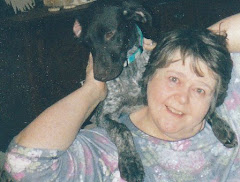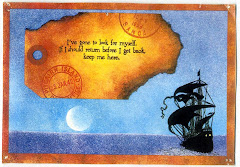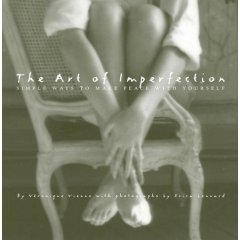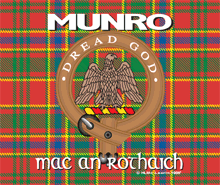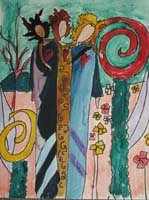
Happy New Year's Eve. I hope your home is a cozy haven tonight, with or without a fireplace (ours is without), and that you are lucky enough to have a couple of dogs or kitties to curl up on the hearth or snuggle at your feet.
 Several of my posts in the last couple of weeks were about Christmas in Scandinavia, in honor of my Norwegian heritage. By doing this, I wasn't neglecting my Scottish heritage. In point of fact, there is little to discuss when it comes to the subject of Christmas in Scotland.
Several of my posts in the last couple of weeks were about Christmas in Scandinavia, in honor of my Norwegian heritage. By doing this, I wasn't neglecting my Scottish heritage. In point of fact, there is little to discuss when it comes to the subject of Christmas in Scotland.Christmas had not traditionally been celebrated there because it was banned for nearly 400 years. Celebrating Christmas was considered by the Church of Scotland - the Presbyterian Church - to be a papist practice.
Until recently in Scotland, Christmas was fairly low key. It wasn't even a public holiday until 1958. Up till then, people worked normally on Christmas day, although the children did get presents.
As a result, most if not all Christmas celebrations nowadays have been brought in from other cultures (notable England and the US.)
Hogmanay (pronounced hɔgməˈne — with the main stress on the last syllable) is the Scots word for the last day of the year. However, tonight is only the start of a celebration which lasts through the night until the morning of January 1 or, in some cases, January 2, which is a Scottish bank holiday.

The roots of Hogmanay perhaps reach back to the celebration of the winter solstice among the Norse, as well as incorporating customs from the Celtic New Year's celebration of Samhain and the ancient Roman Saturnalia.

An old custom in the Highlands, which has survived to a small extent, is to celebrate Hogmanay with the saining - blessing - of the household and livestock. This was done early on New Year's morning by first drinking and then sprinkling 'magic water' in every room, on the beds and all the inhabitants. Then the house was sealed up tight and burning juniper branches were carried through the house and byre.
The smoke was allowed to thoroughly fumigate the buildings until it caused sneezing and coughing among the inhabitants. Then all the doors and windows were flung open to let in the cold, fresh air of the new year. The woman of the house then administered 'a restorative' from the whisky bottle, and the household sat down to their New Year breakfast.

There are many customs associated with Hogmanay. The most widespread national custom is the practice of first footing which starts immediately after midnight. This involves being the first person to cross the threshold of a friend or neighbour and often involves the giving of symbolic gifts such as salt (less common today), coal, shortbread, whisky and black bun (a rich fruitcake) intended to bring different kinds of luck to the householder. This may go on throughout the early hours of the morning and well into the next day. The first foot is supposed to set the luck for the rest of the year.
 My daughter spent Hogmanay in Edinburgh several years ago and reported that it was a night for carousing and drinking in the streets. Revelers included Scotsmen wearing kilts with nothing underneath, not minding (or not feeling) if they froze their arses in the bitter cold! A huge fireworks display is always set off, with Edinburgh Castle in the foreground.
My daughter spent Hogmanay in Edinburgh several years ago and reported that it was a night for carousing and drinking in the streets. Revelers included Scotsmen wearing kilts with nothing underneath, not minding (or not feeling) if they froze their arses in the bitter cold! A huge fireworks display is always set off, with Edinburgh Castle in the foreground.
The Hogmanay custom of singing "Auld Lang Syne" has become common in many countries. A traditional poem reinterpreted by Robert Burns, it was later set to music. It is now common for this to be sung in a circle of linked arms that are crossed over one another as the clock strikes midnight for New Year's Day. Certainly, you are familiar with the words and the tune:
"Should auld acquaintance be forgot,
And never brought to mind?
Should auld acquaintance be forgot,
And days of auld lang syne?
For auld lang syne, my dear
For auld lang syne,
We'll take a cup of kindness yet
For auld lang syne."
Here's another Scots New Year's song that may not be familiar to you (with meanings for the unusual words: Guid - good, ane an' a - one and all, mony - many, baith - both, twa - two, sma' - small, winna- will not, ilka - every, brae - hillside or slope, burnie - small stream, lang - long, hae - have, cot - cottage.
Here's another Scots New Year's song that may not be familiar to you (with meanings for the unusual words: Guid - good, ane an' a - one and all, mony - many, baith - both, twa - two, sma' - small, winna- will not, ilka - every, brae - hillside or slope, burnie - small stream, lang - long, hae - have, cot - cottage.
**********
A GUID NEW YEAR TO ANE AN' A
"A guid new year to ane an' a
An' mony may ye see,
An' during a' the years to come,
O happy may ye be.
An' may ye ne'er hae cause to mourn,
To sigh or shed a tear;
To ane an' a baith great an' sma'
A hearty guid new year.
O time flies past, he winna wait,
O time flies past, he winna wait,
My friend for you or me,
He works his wonders day by day,
And onward still doth flee.
O wha can tell when ilka ane,
I see sae happy here,
Will meet again and merry be
Anither guid new year.
We twa ha'e baith been happy lang.
We twa ha'e baith been happy lang.
We ran about the braes.
In yon wee cot beneath the tree,
We spent our early days.
We ran about the burnie's side,
The spot will aye be dear,
An 'those that used to meet us there,
We'll think on mony a year.
Noo let us hope our years may be
Noo let us hope our years may be
As guid as they ha'e been,
And trust we ne'er again may see,
The sorrows we ha'e seen.
And let us wish that ane an'a'
Our friends baith far an' near,
May aye enjoy in times to come -
A hearty guid new year!"
I hope you have enjoyed these words, along with the images of Scottish Terriers, West Highland Terriers and Corgis sending us their holiday wishes. I leave you with my wish for you tonight, echoed in the words of John Ruskin:
"I wish for you some new love of lovely things,
"I wish for you some new love of lovely things,
and some new forgetfulness of the teasing things,
and some higher pride in the praising things,
and some sweeter peace from the hurrying things
and some closer fence from the worrying things.
And longer stay of time when you are happy
and lighter flight of days that are unkind.”
**********
I am heartily ready for 2008 to be over. Let's hoist our cups to 2009 and shout, in our best Scottish Gaelic, "AGUS BLIADHNA MHATH UR"!
***********
This post is written in memory of my friend Jude's great-hearted Westie, McDuff. A couple of months ago, McDuff simply laid down in the grass one morning and never got up, to the great distress of his human parents and siblings and his beloved doggie sibling, Angus, a Scottie. Now, Angus soldiers on alone, but it is my hope that his family will welcome another dog, whether a Westie or another breed entirely.





















































